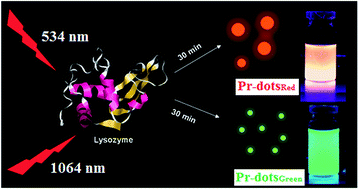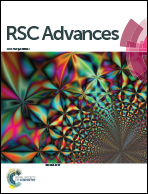Laser-assisted synthesis of multi-colored protein dots and their biological distribution in experimental mice using a dye tracking method†
Abstract
We report a novel method for the synthesis of ultra-bright green and red colored protein dots (Pr-dots) using continuous and pulse lasers (λ = 534 and 1064 nm) with lysozyme as a precursor in ethanol. The quantum yield of the Pr-dotsRed was calculated to be ∼13% and that of the Pr-dotsGreen was ∼15%. A shift in the fluorescent intensity and the fluorescence color of the Pr-dots under UV light (λem = 365 nm) with respect to changes in the repetition frequency of the laser was observed. After successful synthesis of the Pr-dots, their in vivo bio-kinetics were studied using 5 week old ICR mouse models. The highest accumulation of multi-Pr-dots was observed in the brains of the mice. This method has opened a new door to pursue the application of Pr-dots to ferry drugs across blood–brain barrier (BBB) which is considered very difficult to achieve. Another vital application of the Pr-dots in biological imaging was explored. These multi-colored Pr-dots were used as effective fluorescence probes for the imaging of Vero cells as well as MCF 7 cancer stem cells.


 Please wait while we load your content...
Please wait while we load your content...